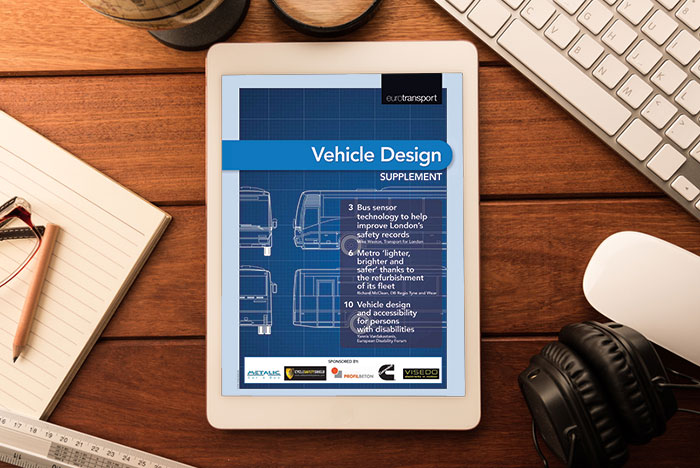Vehicle Design supplement
- Like
- Digg
- Del
- Tumblr
- VKontakte
- Buffer
- Love This
- Odnoklassniki
- Meneame
- Blogger
- Amazon
- Yahoo Mail
- Gmail
- AOL
- Newsvine
- HackerNews
- Evernote
- MySpace
- Mail.ru
- Viadeo
- Line
- Comments
- Yummly
- SMS
- Viber
- Telegram
- Subscribe
- Skype
- Facebook Messenger
- Kakao
- LiveJournal
- Yammer
- Edgar
- Fintel
- Mix
- Instapaper
- Copy Link
Posted: 22 December 2014 | Intelligent Transport
In our latest free-to-view Vehicle Design Supplement, Mike Weston from TfL gives details about bus sensor technology trials in London; Richard McClean from DB Regio Tyne & Wear explains the Metro’s massive refurbishment programme; and Yannis Vardakastanis from the EDF outlines the importance of vehicle design for persons with disabilities…


- Bus sensor technology to help improve London’s safety records
For more than 120 years, London’s roads have played host to the iconic red bus. From humble beginnings of horse-drawn ‘Shillibeers’, the fleet has now grown to 8,700 buses and account for more than a quarter of all road journeys in the city, with many running through the day and night. An increase in the number of bus journeys plus an increase in the number of cyclists and pedestrians also increases the chances of accidents, but one of Transport for London’s (TfL’s) top priorities is to reduce the number of people killed or seriously injured on London’s roads by 40% by 2020. For Intelligent Transport, TfL’s Director of Buses, Mike Weston, tells us what technology is being trialled on London’s buses to help improve its safety records. - Metro ‘lighter, brighter and safer’ thanks to the refurbishment of its fleet
The £30 million modernisation of the Tyne and Wear Metro’s train fleet has past the half-way point, and eyecatching new features and functional changes are now emerging across the system. Nexus, the public body which owns and manages Metro, commissioned the fleet refurbishment project in 2010 when modernisation funding was given the green light by the UK Government. Throughout the project, at stations, on trains, and for staff, operations have very much been business as usual. Managing Director of DB Regio Tyne and Wear, Richard McClean, gave Intelligent Transport an update on the refurbishment work. - Vehicle design and accessibility for persons with disabilities
President of the European Disability Forum (EDF) – Yannis Vardakastanis – says that the three main points which can make a difference concerning the design of public transport vehicles include boarding, space allocation, and information. For Intelligent Transport, Yannis takes a further look into these features which can be helpful to improve accessibility for persons with disabilities.
This Vehicle Design supplement is restricted - login or subscribe for free to access
Thank you for visiting our website. To access this content in full, you'll need to login or subscribe.
It's completely free to subscribe, and in less than a minute you can continue reading. If you've already subscribed, just login.
Why subscribe? Join our growing community of thousands of industry professionals and gain access to:
- Quarterly issues in print and/or digital format
- Case studies, whitepapers, webinars and industry-leading content
- Breaking news and features
- Our extensive online archive of thousands of articles and years of past issues
All for free!
Click here to Subscribe today Login here
Related topics
Fleet Management & Maintenance
Issue
Issue 6 2014
Related organisations
Cummins, DB Regio Tyne and Wear, European Disability Forum, Metallic Car & Bus, Nexus, Profilbeton, Safety Shield Systems, Transport for London (TfL), Visedo Oy
Related people
Mike Weston, Richard McClean, Yannis Vardakastanis








